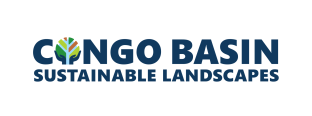
Congo Basin Sustainable Landscapes Programme
Key background
Located in Central Africa, the Congo Basin contains the earth’s second largest area of contiguous moist tropical forests, stretching from the Gulf of Guinea in the west to the Rift Valley in the east, and containing more than 2.87 million km2 of both humid and dry forests. The Congo Basin rainforest extends over the territories of six countries namely (in alphabetical order) – Cameroon, Central African Republic (CAR), the Democratic Republic of Congo (DRC), Equatorial Guinea, Gabon, and the Republic of Congo (RoC). The five main forest types include swampy forests of the central zone, dryland rainforest around this central basin, drier forest types in the north and south of the basin, patchwork forests and savannah moving away from the centre of the basin, and finally, woodlands and wooded savannah in the north of Cameroon and CAR, and in the south of DRC.
In addition, the recently mapped peatlands of Cuvette Centrale in the Congo Basin are estimated to be the largest continuous tropical peat complex in the world at 167,600 km2. Estimates show that it stores around 30 gigatons of carbon, equivalent to two years of global greenhouse gas emissions, making the Congo Basin the largest carbon sink on this planet.
The forests of the Congo Basin are a biodiversity hotspot; they are home to a rich fauna of more than 1,000 species of birds, 700 species of fish and more than 400 species of mammals, including emblematic species like the forest elephant. The DRC is one of the 5 megadiverse countries in world hosting the endemic bonobo and okapi, and the Congo has the highest densities of Western Lowland gorillas. There is also a remarkable diversity of plants, with estimates of over 10,000 species, many of which are unique to the region.
The threat
Approximately 130 million people live in the region, and almost two-thirds of them are in rural areas. Most of these people depend directly on forest resources for their livelihoods. This includes indigenous peoples who are the custodians of cultural traditions and ancestral knowledge passed down from generation to generation.
However, the forest ecosystems of the Congo Basin are facing increasing threats from human activities. Among these, family farming and logging are two main causes of deforestation and forest degradation. Fires, large-scale agriculture, infrastructure construction and mining are other factors that contribute to the loss of forest cover.
Another factor is the overexploitation of wildlife, which threatens the survival of many species. Unsustainable hunting and poaching for wild meat are draining forests of wildlife, while illegal trade and trafficking are leading to the collapse of large mammal populations.
These threats, often transboundary in nature, are linked to problems with land-use planning and management, forest governance, or law enforcement. To add to the worrying situation, the effects of climate change, such as rising temperatures and disrupted rainfall, are increasing the risk to the region's forests and biodiversity.

The solution
To protect and preserve the Congo Basin in the face of these threats, the Global Environment Facility (GEF) approved in June 2019 the Congo Basin Sustainable Landscape Impact Programme (abbreviated to the Congo IP). This programme is one of the largest currently underway in the region. It has a total funding of more than $60 million from the GEF over the period 2020-2025 comprising seven projects, one regional and six national in the following countries (lead GEF Implementing Agency in parenthesis): Cameroon (WWF-US), Central African Republic (World Bank), DRC (UNEP), Equatorial Guinea (IUCN), Gabon (UNDP), and the Republic of Congo (UNEP).
The regional project will contribute to the long-term goal of healthy and thriving forest ecosystems in the Congo Basin while protecting and maintaining forest cover and peatlands, maintaining stable wildlife populations, and empowering local forest-dependent communities to manage their land and improve their livelihoods, while ensuring exploitation of natural resources is sustainable, with cross-sectoral and transboundary land-use planning in place.
The six national projects will contribute to the objectives of the regional project. Through collaboration and inclusive processes involving government agencies, partner institutions and organizations, universities, indigenous leaders and local communities, and private entities, Congo IP aims to work across national boundaries in an integrated and networked approach.
The ultimate goal of the Congo IP is to have a positive and lasting impact on biodiversity, sustainable forest management and local livelihoods, with a development perspective and in line with country priorities.
The regional project is designed to address barriers to regional dialogue and collaboration on actions to promote sustainable forest management in the six Congo Basin Forest countries through the following five components:
- Component 1: Provide a framework for integrated transboundary land use planning and mobilisation of local, national, and international investments for sustainable land management and sustainable forest management.
- Component 2: Ensure the long-term sustainability of forests and area-based management of high conservation value forests providing important habitat for threatened species and essential ecosystem services.
- Component 3: Strengthen the rights and tenure of local communities and forest-dependent people, as well as collaboration with the private sector, for sustainable forest use.
- Component 4: Manage and disseminate knowledge to strengthen the integration efforts of the six countries in the region.
- Component 5: Coordinating and communicating the programme.
More information about the Programme here.


